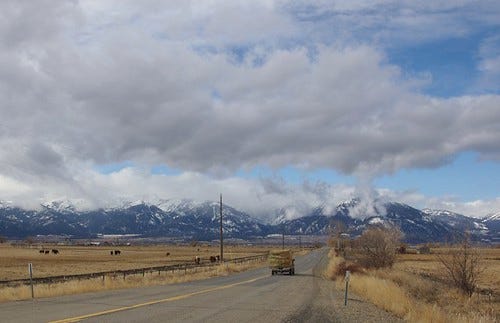Mayor Loran Joseph: Winter is coming
Now, more than ever, it is important to take the 3 Ws to heart: Wear a mask, Wash your hands, and Watch your distance.
Loran Joseph is the Mayor pro tem of Baker City
Ignorance is not bliss; it’s deadly

"Blue Mountains Near Baker City, Oregon" by A.Davey is licensed under CC BY 2.0
When you live or grow up in rural Oregon you learn some things that our urban counterparts have difficulty understanding: milk needs to be shaken before you drink it, the meat on your dinner plate used to have a name, daylight savings time doesn't change anything, and COVID-19 won't impact our community. Wait, what? I think it is past time to revisit that last one.
In Baker County and much of rural Oregon, we have avoided many direct effects of the novel coronavirus. Case in point, our COVID-19 death count to date in Baker County is three. Shielded from the physical effects, the indirect effects of the coronavirus—restaurant closures, increased PPE costs, hospital access restrictions, school closures, layoffs, supply chain disruption, virtual everything, etc—have impacted rural Oregonians. Weighing the direct effects—three deaths that people around here will be quick to tell you may be better explained by underlying medical conditions—against the indirect effects raises a question for many: are we sure that the cure isn't worse than the disease?
This is dangerous thinking. Unfortunately it permeates rural Oregon and rural America. The lessons learned from Spain, Italy, New York, and many other areas have been forgotten or disbelieved. The drumbeat of "winter is coming" became background noise and the precautions we've all been taking fatigued us. Every safety measure we institute that works to slow the spread or reduce the severity of the disease is disregarded because the disease spreads so slowly or isn't as severe as expected. News media that depends on viewership/readership to pay the bills have moved on to other stories as our mental states require a break from the "doomscrolling" of 2020. Cumulatively, precautions seem overtop and the virus news seems outdated. It’s a vicious Catch-22-style cycle that has only gotten worse as the majority of Oregonians mask up and play it safe.
We need a call to action, we need to recognize how lax we've become and remember how dangerous this virus was last winter. I know those places we read about in the news seem far off, but they could very easily be us. We forget that people are the same across this world, that human nature is a constant in every society and culture. More importantly, those lessons are cropping up again in places closer to home and we aren't listening. Just this week I saw news articles about hospitals in Idaho nearing capacity with COVID-19 patients. Discussions were had of flying overflow patients to Portland or Seattle.
The saddest part of the situation? The local paper didn't pick it up, social media didn't comment on it, and people in my community are still making trips to coronavirus hot spots across the border without masks or any precautions really.
The desire for normalcy has tricked our brains into hearing only what we want to hear and disregarding the rest. Cases are up? Too much testing! The neighbor died? He was old! Hospitals are filling up? My friend's brother who works at a hospital says there's plenty of room!
I'm going to make the best case I can for everyone to up their vigilance and recommit to taking precautions against the virus this winter. Here's a link to data from the CDC on excessive deaths. Go ahead and follow it. Read it.
I hope you clicked the link. I hope you read how excess deaths are calculated. I hope you interacted with the data and used it to answer some questions you may have or create new ones. If not, here's my take on it:
Total predicted number of excess deaths since 2/1/2020 across the United States:
236,480 - 318,355
That number has nothing to do with testing. It has nothing to do with COVID-19 diagnoses. That is the number of deaths since February 1st above what we would expect in a normal year. If you follow the data in the link back to the flu season of 2017/2018 you can see six weeks of excess deaths ranging from 1 - 13% above normal. Since the week ending March 28th we have seen excess deaths for EVERY WEEK ranging from 3 - 40% above normal. We are so far past this being "just like the flu" or "they were going to die anyway!"
We have entered the realm of American crisis, so why doesn't it feel that way here in rural Oregon? Well because Oregon's predicted number of excess deaths is only 271 - 1,773. That should not come as a relief to you. That should be terrifying. That should make you spit whatever drink you just sipped all over this article you are reading. Go get a napkin, I'll wait for you.
Those numbers mean that we haven't experienced anything yet, that the coronavirus we've seen so far is just a tease. Or, as Allen Banks (the Idaho Panhandle Health Board representative from the County of Bonner) says, "Something is making these people sick - and I'm pretty sure it's not coronavirus - so the question you should be asking is, what is making them sick?" I cannot for the life of me imagine a scarier Halloween scenario than someone in a position of authority being confronted with the inescapable fact of hospitals that are over capacity turning away sick patients, and still denying what experts have been telling us since February. That quote from Mr. Banks came out in the news October 23rd in an article about the Idaho Panhandle dropping their mask mandate despite testimony from hospital staff on how overwhelmed they are from COVID-19 patients.
How are we not paying attention?
How can we be oblivious to what our canary of a neighbor is going through?
How can a news cycle be so short that less than a week later the story is buried?

“Look, a squirrel!!” "Angry squirrel" by @Doug88888 is licensed under CC BY-NC-SA 2.0
While we have made great economic, social, emotional, and mental sacrifices here in Oregon, we can't deny it has kept us physically safe. Our vulnerable populations haven't been put in the dangerous situations we saw on the East Coast yet and I hope we can appreciate that. Hindsight is always 20/20 and there were problems with our state and national responses undoubtedly, both for the economic impact and the health impacts. However, we now have data—real concrete evidence that masks work, that this virus kills, and that we need to double down on what we can personally control. As I write this my rural community has gone from three new cases over a span of two weeks to 26 new cases in five days. Now, more than ever, it is important to take to heart what the Baker County Health Department says: "We know that by following the 3 W's (Wear a mask, Wash your hands, and Watch your distance) we can help slow the spread of COVID-19."
So mask up and get ready, because after nine long months, winter is here.
********************************
Keep the conversation going: Facebook (facebook.com/oregonway), Twitter (@the_oregon_way)
#51



